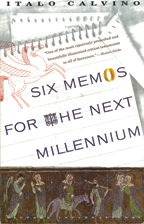 |
Italo Calvino. Six Memos for the Next Millennium. New York: Random House, Vintage Books, 1993.
Six Memos for the Next Millennium is a book of lectures written by Italo Calvino that he was never able to deliver, having passed away before giving them in 1985. The memos discuss his categories of the key values of literature, including Lightness, Quickness, Exactitude, Visibility, Multiplicity and Consistency.
What impresses me most about this book is Calvino’s ability to be incredibly focused on a seemingly narrow topic and yet so expansive at the same time. My favorite chapter is “Lightness.” In it, he explores the concept of lightness with more weightiness and lack of frivolity than one can imagine. With references ranging from Dante to Borges, as well as Kafka to Medusa and Don Quixote, this book continues to provoke me to attempt to unravel as many layers from the smallest of onions all of the time.
|